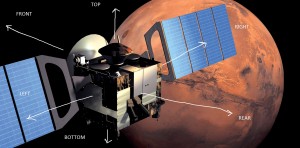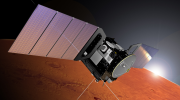This week’s report on how the Mars Express flight control team is planning to deal with Comet Siding Spring is all about attitude – Ed.
We have now finalised our choice for spacecraft attitude through the comet encounter. As we’re sure many of you have also worked out, our chosen attitude is with the High Gain Antenna (HGA) facing the comet.
This was identified early on as a likely attitude as there are no internal components mounted directly on the front wall, plus the HGA should act as an improvised Whipple shield.
I’m in control, my worries are few
‘Cause I’ve got love like I never knew
Ooo, ooo, ooo, ooo, ooo
I got a new attitude
– Patti Labelle, ‘New Attitude’
It is not perfect, however, as there are still several components in the ‘firing line’ of cometary dust particles. All antennas will be facing the incoming dust particles, but one or two holes in the parabolic reflector dish of the HGA shouldn’t prevent it from functioning. The ASPERA instrument is also exposed, as is the forward Sun Acquisition Sensor (SAS) and two of the thruster pairs.
As the angle between the comet and the Sun will be around 89°, we also had to decide which of the faces (i.e sides of the spacecraft) should point towards the Sun.
As the solar panels are mounted on the left and right sides, if they were pointed at the Sun only the array on the side facing the Sun would be illuminated – and only on its end, so Mars Express would not be able to rely on solar power. The batteries are not able to support this configuration sufficiently long (up to 10 hours).
Pointing the top surface – where the instruments are located – toward the Sun is generally not a good idea, but pointing the base – where the thrusters are – toward the Sun does not cause any problem (see our diagramme of MEX sides here – Ed.).
Actually, this would provide some extra heat to the spacecraft fuel tanks and lines so we can save some power by not needing to use the on-board heaters as often. This angle also works out well for our solar arrays. They can still be facing the Sun (for full power) and yet lie edge-on to the expected particle ‘flux’ (stream of incoming particles), therby presenting the smallest target.

Mars Express with the solar arrays edge on – as they are only 20mm thick they had to be drawn larger to even be visible in this picture
So now that we have chosen our attitude, we now have to ensure that we stay so oriented!
Our current modelling shows that it is unlikely that an impact from the types of particles we expect could disturb the spacecraft’s attitude. Even if it did, the on-board systems should be able to compensate. What we are more concerned about is if an impact were to cause a component to fail or behave strangely. This could then cause the on-board systems to think that the spacecraft is at risk and trigger a ‘safe mode’.
Safe mode can be considered a spacecraft’s survival instinct; it’s a mode that MEX enters automatically if it detects a condition or event that indicates loss of control or damage to the spacecraft. Usually the trigger is a system failure or detection of operating conditions considered dangerously out of the normal ranges. All non-essential systems are shut down and those that are vital will switch to their backup way of functioning; this is to try and isolate any suspected problem and prevent it from causing damage.
When a safe mode is triggered, the spacecraft automatically uses its SAS to point the front of the spacecraft and the solar arrays towards the Sun (ensuring that MEX has power). Next, the active Star Tracker (STR) makes a scan to determine in which attitude the spacecraft has ended up. With this knowledge the spacecraft consults an internally stored table containing the position in the sky of the Earth at that moment to determine in which direction the HGA needs to be pointed to re-establish communications. The spacecraft body is then rotated to point the HGA in that direction while simultaneously keeping the arrays facing the Sun.
The craft then starts sending a signal to Earth and waiting for a reply.
There are two transmitter types on MEX: X-Band and S-Band (we’ll explore why in a later post), but in safe mode, the spacecraft uses the lower bandwidth (and less complex) S-Band system at its lowest transmission rate, which results in a painfully slow communication rate of 9 bits per second (in comparison: in X-Band the maximum rate is 228 thousand bits per second!)
Furthermore, in entering safe mode, a small amount of fuel is consumed and the communications are a bit annoying (until we can restore the faster X-Band) but safe mode is by definition ‘safe.’
So, two questions (you may have to go back a few posts for clues):
- What do you think the problem would be if this were to happen on 19 October?
- What are the weak points on the front of Mars Express?
(Click below on ‘Page 2’ for answers – Ed.)
We’re also working on another plan to avoid nasty bits of comet, but we’ll save that for next time…
– Andy, Michel, Kees, Simon, James and Luke







Discussion: one comment
Excuse me an off-topic question, but this ks od great interest to me…
How does a research go with respect to last Phobos fly-by ?
When any results will be published ?
TIA